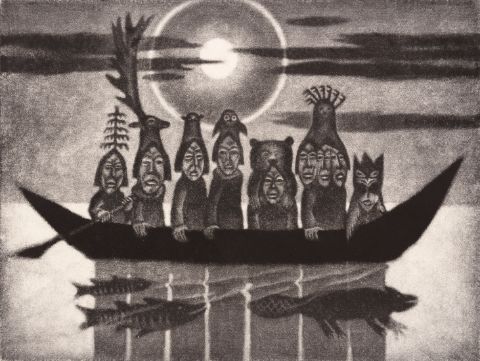Kaljo Põllu

Kaljo Põllu, Päikesevene (Sunboat), 1974. Courtesy of University of Tartu Art Museum
A seminal figure in Estonian art history of the twentieth century, Kaljo Põllu tapped into the ancient Finno-Ugric past and its ancestral beliefs to create mythical worlds. After leading the vanguard of contemporary art in 1960s Estonia and contributing to the development of the local pop, op, and kinetic art movements, Põllu became increasingly interested, in the following decade, in his homeland’s roots and the ancient ethos of the Finno-Ugric kin. Perfecting the mezzotint print technique, he created graphic series such as Ancient Dwellers, Kali People, and Heaven and Earth, which depict ancient beliefs, mythologies, and the symbiotic relationship between humankind and nature. Two Sun Elks from the Kali People series explores the notion of duality in the world, while Shrine from the Heaven and Earth series illustrates a sacred ancestral site of worship. While teaching at the Estonian Academy of Art in Tallinn, Põllu embarked on numerous field trips to study the cultures of kindred peoples: the Saami, the Khanty, the Mansi, the Karelians, the Udmurts, the Erzya, the Mokshas, and others. Delving into these ancient histories and cosmologies, he did not seek to convey an ethnographic aesthetic; instead, he created his own speculative universe, connecting a mythical past with the present and future.
Works in the exhibition:
Two Sun Elks (1978), mezzotint, 53.4 × 46.7 cm
Legend (1974), mezzotint, 46.2 × 59.3 cm
The Shrine (1987), mezzotint, 79.6 × 59.0 cm
The Blessing of the Earth (1988), mezzotint, 72.2 × 59.8 cm
To Mother Earth (1975), mezzotint on paper, 46.4 × 52.2 cm
Päikesevene (Sunboat) (1974), mezzotint, 37 × 49 cm